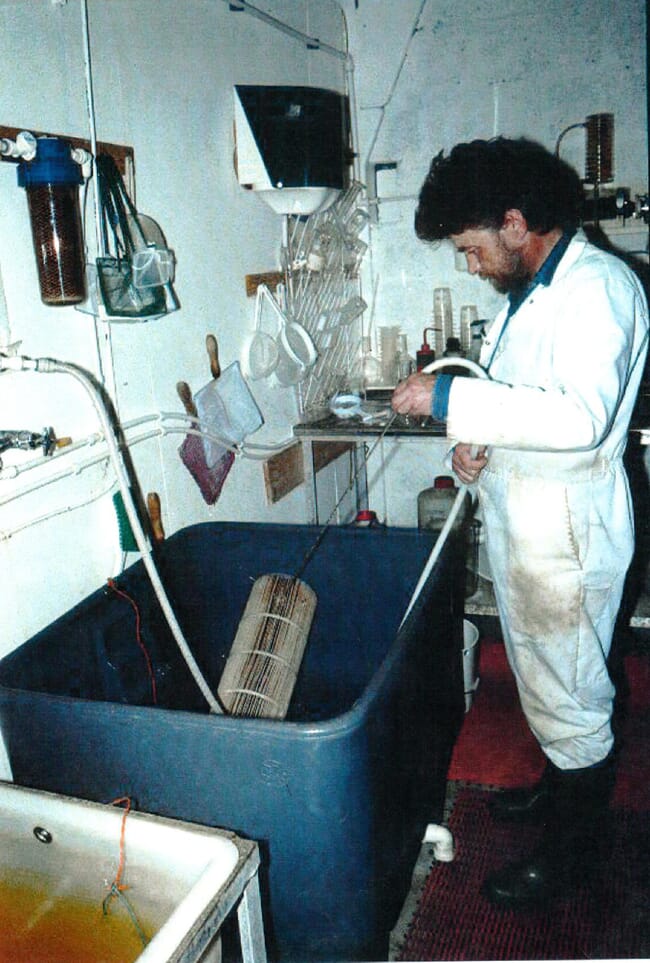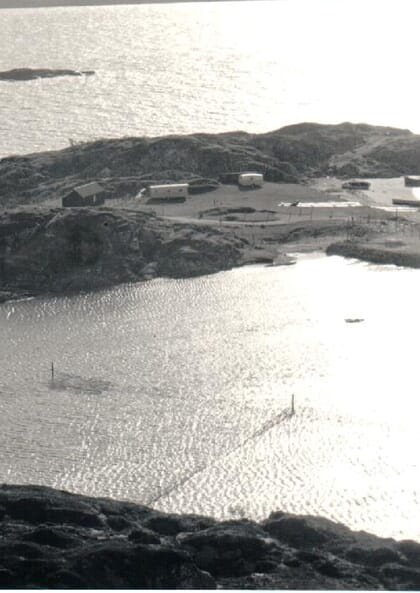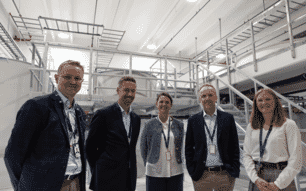“The only other people who’ve been in the same place for 45 years are the Kray twins – it’s the same as three consecutive life sentences with no time off for good behaviour,” jokes Jon Sherwood, who celebrated his 45th anniversary at Ardtoe Marine Laboratory last month.

Jon, who is now principle hatchery technician, joined straight from school. He arrived at the lab, which was then run by the White Fish Authority, on 12 July 1973, following an intervention from his mother, who was fed up with watching the young Jon “messing around with his mates on motorbikes”.
“I was from Nottingham, about as far away from the sea as you can get in the UK, but I’d always been a keen coarse angler and was always interested in fish and natural history. I was quite happy playing around on motorcycles with my mates, but was probably a bit of a burden to my mother and when she saw an article about the White Fish Authority, she wrote for information about the work they were doing and potential job opportunities in that field,” explains Jon.
“The officer in charge of Ardtoe wrote back and said there was a job available if I wished to apply. I came up here for an interview… and the rest is history,” he continues.

Jon’s first role was at the marine site in Loch Moidart, about four miles by boat from Ardtoe, where he took part in cage trials ongrowing a variety of marine fish species – mainly flatfish, such as plaice, to begin with.
He quickly saw the appeal of a role that allowed him to be out on the water, learning about all manner of wildlife, despite the fairly basic nature of the facilities at the time.
“The site was just a collection of about half a dozen wooden sheds, and the cage site was essentially a small experimental unit with cages of six foot by six foot,” he recalls. “But I was really impressed, as it was a good summer and I enjoyed going to and from site by boat. When I first came up I had an Observer’s guide to the seashore and I used it as a bible, going out lifting lobster pots and identifying all the different species.”
He was also excited to be involved at a time when finfish aquaculture was first taking off in the UK.
“It was literally the beginning of fish aquaculture in this country; it was about the same time as Marine Harvest were starting salmon farming at Lochailort,” he explains.
Ardtoe, which celebrated its 50th anniversary in 2016, has been run by a variety of companies – most recently being taken over by Benchmark – and it has evolved considerably over time.
“It was chosen in 1966 as a suitable place to create a lagoon using two short dams, and the idea was to catch juvenile plaice on the nearby beaches and then ranch them in these ponds. However, the lagoons failed. There were too many predators – crabs and herons and otters – so it was never really feasible. So they decided to make it into a pump-ashore unit instead,” Jon explains.
When the White Fish Authority and Herring Industry Board amalgamated in 1981, it fell under the remit of the newly created Seafish Industry Authority, who built a selection of new units.
And by 1986, after 13 years based at Ardtoe’s marine cage site, Seafish decided to move all production to land-based units, and Jon began to specialise in the hatchery side of the business. Projects he took part in included establishing a shellfish unit to investigate the feasibility of scallop culture, and a programme that involved growing and releasing lobsters off Orkney in a bid to supplement wild stocks – initiatives that allowed him to draw on his skills as a diver.
“Releasing microtagged lobsters at two inches long and finding they’d survived up to market size has definitely been one of the highlights,” he says. “It was one of the most amazing things: we were releasing them onto the seabed to try to ensure they found cover, but there were constantly fish on our shoulder which were coming in and mopping up the little lobsters – there was nothing we could do about it.”
Since then he’s worked with a selection of marine fish, including plaice, turbot, halibut, cod, haddock, Dover sole, lumpsuckers, goldsinny and ballan wrasse.
“Every species is different but you can normally find a way of adapting the equipment or techniques to suit that particular species. Overcoming these challenges with new species is one of the things that keeps the job interesting – when you get it to work it’s very rewarding,” he reflects.
One landmark for Jon came in the early days of the industry working with wrasse.
“I produced the first hatchery-produced wrasse – goldsinny – in the UK, perhaps even in the world, back in 1992. In those days no one wanted ballan wrasse because if you get your size ratio wrong between the wrasse and the salmon the wrasse will actually pluck the eyes out of the salmon,” he explains, “and many of those who used cleanerfish first time round are still wary of using them today.”
And, despite working away quietly in the background, he’s still breaking new ground.

“Just last year we came up with a new technique for feeding pellets to ballan wrasse. They’re used to a live diet, and are notoriously hard to wean onto formulated diets. As a result, I came up with a feeding system that gives the pellets a bit more movement and makes them more appealing than simply scattering them onto the surface. It’s about presenting the feed in a different way and using attractants to make the pellets more appetising,” he explains.
While he’s enjoyed the variety, he has clearly preferred some species to others.
“I liked working with cod and haddock. They’re relatively straightforward, as they’re natural spawners, so we never had to strip them. Little, tubby cod juveniles are such lovely, good-looking fish too,” he says.
“Halibut on the other hand were a nightmare – the fact that they naturally spawn in a zone that’s cold and pitch black and salty meant that trying to emulate those conditions in a tank that’s only a couple of metres deep wasn’t easy.
“We had to strip them in the middle of winter, at night, so that the ovulation was at precisely the right stage. You’d be standing up to your knackers in freezing cold water stripping these monstrous fish. It was horrible,” he chuckles.
There have, Jon admits, been both highs and lows to his time at Ardtoe, but he attributes his longevity in his role to a number of factors, not least having a sense of humour. And he has also enjoyed seeing how various projects have evolved and developed, even if he does have some nostalgia for the early days.
“It’s much more refined now; in the old days there was a lot of bucket science. It was really good fun. It was more of a pathfinder industry and there was a real feeling of breaking through the frontiers. Now there’s far more emphasis on health and safety and biosecurity – words that weren’t used at all in my early days. Which was probably just as well because we got a lot done. We weren’t restricted,” he explains.

He has, however, also been open to new developments in hatchery techniques and technologies and was particularly impressed when he started using INVE’s magnetised artemia cysts – which allow the non-viable ones to be removed without a time-consuming and laborious decapsulation process – last year.
“They’re a brilliant product. I used to spend hours decapsulating artemia, which involved using nasty chemicals – a mixture of hydrochloride and sodium hydroxide,” he says.
Jon also sees the potential in a new machine – Varicom Aqua’s high-density rotifer system – which, once he got the hang of it, has allowed him to improve rotifer production at the site.
“It made my life considerably more complicated for a while, while we tried to work out the calibration – we use an algae paste and there was at one occasion we overloaded it and it produced a green mushroom cloud,” he chuckles. “But we got on top of it this year – it’s an automated rotifer production method, as opposed to a batch-culture system, and is much less labour intensive.”
Being involved in such developments is part of the reason he’s still in the same role, but he feels there’s still scope for the UK aquaculture industry to keep evolving.
“It’s a good time to be in the sector, but I’d like to see more support for the culture of marine species here – other countries are very into it – even if we’re limited in what we can produce by the lower water temperature,” he explains.
And he also feels that Ardtoe, following its acquisition by Benchmark, should play an important part in the industry’s evolution.
“Ardtoe always has been and always should be focused on research into both new and existing species –there are areas within every species that could do with extra work, especially with wrasse and lumpsuckers. I always get the impression these days that people think you can take a species and immediately farm it. Considering that the salmon industry has taken 50-odd years to get to where it is now and is still developing… the same should be said for any species,” Jon reflects.
“We haven’t got the tank capacity for cleanerfish production so I’d like to focus on test trials – so we can fine-tune the techniques to produce top-quality ballan wrasse, increase survival rates at weaning and improve the productivity of them in captivity, perhaps in partnership with some of the major salmon producers. It’s always been regarded as a world-class facility and I’m sure it can regain that status,” he adds.

Over time, Jon’s work has had a significant impact worldwide on the understanding of marine species and he has also published a number of papers – most recently contributing to a chapter on wrasse hatcheries in Cleaner Fish Biology and Aquaculture Applications, edited by Ardtoe’s research director, Jim Treasurer. And he hopes that he’ll continue to contribute to practical advances in the industry, in particular finding ways to improve wrasse production.
“I’d like to see a standardised wrasse-production protocol – from broodstock through to cage-worthy fish. I think there’s still a lot to learn with broodstock nutrition, egg production, larval rearing, everything. Marine Harvest have been doing it at Machrihanish for nine years now but there’s still a long way to go. I think the major bottleneck is this weaning problem and I’d like to see that overcome,” he says.
“I’m sure it’s feasible. It’s all about diet presentation and formulation. I think they’re pretty fussy and need a shrimp-based diet – ballan wrasse are not keen on fish-based products at all and they mainly eat shellfish, particularly crustaceans, in the wild and probably don’t like prey that are too fast moving, like sprats. If you watch them in the tanks they’re very laid back, compared to, for example, cod juveniles, or salmon, which will constantly be swimming around in circles.”
Given his continued enthusiasm and ambition, it seems conceivable that Jon might achieve a half-century at Ardtoe, but he dismisses such an idea.
“Heaven forbid – I’d be 68 by that point and I’m already pretty cantankerous, so I’m sure I’ll be forced out by then,” he jokes. “It’s been a journey, but it’s on the up again which is pleasing.”
“And I still get excited. It’s very satisfying seeing a transport lorry leaving the site filled with fish that you’ve grown – and from three relatively small batches of ballan wrasse larvae we managed to produce over 10,000 weaned juveniles last year,” he adds.
Outside of work he counts geology, palaeontology, natural history, sea fishing, hillwalking and lepidopterology amongst his interests.
“I’ve got a moth trap and catch a lot of different species, depending on the time of year. I’ve found some unusual species, and am particularly keen on the larger hawk moths like the tiger moths and the death’s-head hawk moth – it’s got a skull on its back and can actually squeak. One turned up in Acharacle one year to great excitement, but I’ve yet to see one myself.”
Despite having spent much of the last half century on or under water, like his moths, Jon now has ambitions to take to the skies, with an introductory flying lesson – as a present from Benchmark – lined up for September.
Given that he’s lived within nine miles of Ardtoe since he started working there it seems his homing instinct is still strong.
“I’ll be taking off from Connel Airport and I’m hoping to fly over the lab,” he says.
Seeing the lab from a fresh perspective could be the perfect way to reflect on all he’s achieved.




